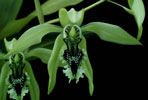|
|
|
|
|
| |
Divisions of
Coelogyne pandurata '#1' |
|
| |
|
|
| |
| Number: |
TN8268 |
| Name: |
Coelogyne pandurata '#1'
|
| Type: |
division (What's that?) |
|
Plant Donor: |
Troy C. Meyers
|
|
Click to Enlarge

Flower |
Click to Enlarge

Labellum |
Click to Enlarge

Capsule at 118 days |
Click to Enlarge

Emptied Capsule at 227 days |
|
|
|
| |
Culture Notes from Donor: Parent plant: Temperature range I (60-83°F)
Comments: Parent plant: Wonderfully sweet musk scented during the heat of the day.
For additional origin/habitat information supplied courtesy of
Charles and Margaret Baker, see further below, near the bottom of this page.
|
Temperatures we attempt to use in the lab & greenhouse:
| For Species: |
|
Spring, Summer, Autumn, Winter: days average 89°F, nights 74°F; best fit is warm 90-70°F
(Source:
Baker's Web OSC) |
|
About the name...
| Etymology of |
Coelogyne |
|
From latinized Greek "koilos" hollow, cavity; "gyne" woman, womb, stigma. The column is frontally hollow.
(Source:
Mayr & Schmucker 1998) |
| Etymology of |
pandurata |
|
From Latin "panduratus" lute-shaped.
(Source:
Mayr & Schmucker 1998) |
| Pronunciation of |
Coelogyne |
|
see-LAW-ji-nee
(Source:
Hawkes 1978) |
| Pronunciation of |
pandurata |
|
pand-yoo-RAH-ta
(Source:
Hawkes 1978) |
|
If you would like to direct someone to this web page, please copy and paste this URL into your email:
http://troymeyers.com/d?128268
|
DIVISIONS
of these are not currently available, but we have some maturing in the greenhouse and expect to offer them in the future.
There is 1 item with
1 plant per
item that will be considered for sale later.
Click here to see if we have flasks available.
|
|
|
| |
The origin/habitat information below is supplied courtesy of Charles and Margaret Baker
The following information is based on the name of the plant provided by the donor, and assumes that the name is correct. If the plant has been misidentified, then the following information may not be correct.
This text is copyrighted by the Bakers and may not be reproduced without permission.
ORIGIN/HABITAT: Plants are reported in Malaya, Sumatra, Borneo, and the
Philippines on Mindanao, Luzon and Samar Islands. They generally grow on
old trees by rivers, near the coast, or in hot, damp, swampy lowlands.
More about this information and the Bakers...
|
|
|
| |
|
|
|